
The Tlatelolco massacre was a military massacre committed by the Mexican Armed Forces against the students of the National Autonomous University of Mexico (UNAM), the National Polytechnic Institute (IPN), and other universities in Mexico.

The National Autonomous University of Mexico, is a public research university in Mexico. It has several campuses in Mexico City, and many others in various locations across Mexico, as well as a presence in nine countries. It also has 34 research institutes, 26 museums, and 18 historic sites.

Monterrey Institute of Technology and Higher Education, also known as Technological Institute of Monterrey or just Tec, is a private research university based in Monterrey, Mexico, which has grown to include 35 campuses located across 25 cities in the country and 22 liasion offices in other 15 countries.

Gustavo Díaz Ordaz Bolaños was a Mexican politician and member of the Institutional Revolutionary Party (PRI). He served as the President of Mexico from 1964 to 1970. Previously, he served as a member of the Chamber of Deputies for Puebla's 1st district, a senator of the Congress of the Union for Puebla, and Secretary of the Interior.

Azcapotzalco is a borough in Mexico City. Azcapotzalco is in the northwestern part of Mexico City.

The Metropolitan Autonomous University also known as UAM, is a Mexican public research university. Founded in 1974 with the support of then-President Luis Echeverria Alvarez, the institution aims to be closely linked to the social and human environment.
The 1999–2000 strike and shutdown of the UNAM had its origins in the January 1999 announcement by its latest rector that tuition would increase significantly and graduation requirements would become more restrictive. In response, a large group of students declared a strike and blockaded the main campus to the point of institutional paralysis. The blockades intensified and eventually led to the university's closure, during which there were violent encounters between opposition groups, students, guards and faculty. The crisis led to the eventual resignation of the university's rector and appointment of a new one. Along the way, bloody conflicts resulted in serious injuries and even fatalities on the unlawfully occupied campus. Eventual action by the recently created federal police finally ended the occupation during February 2000.
Javier Barros Sierra was a Mexican engineer and rector of the National Autonomous University of Mexico during the 1968 Tlatelolco massacre.

Campus protest or student protest is a form of student activism that takes the form of protest at university campuses. Such protests encompass a wide range of activities that indicate student dissatisfaction with a given political or academics issue and mobilization to communicate this dissatisfaction to the authorities and society in general and hopefully remedy the problem. Protest forms include but are not limited to: sit-ins, occupations of university offices or buildings, strikes etc. More extreme forms include suicide such as the case of Jan Palach's, and Jan Zajíc's protests against the end of the Prague Spring and Kostas Georgakis' protest against the Greek junta of 1967–1974.

The Mexican state of Oaxaca was embroiled in a conflict that lasted more than seven months and resulted in at least seventeen deaths and the occupation of the capital city of Oaxaca by the Popular Assembly of the Peoples of Oaxaca (APPO). The conflict emerged in May 2006 with the police responding to a strike involving the local teachers' trade union by opening fire on non-violent protests. It then grew into a broad-based movement pitting the Popular Assembly of the Peoples of Oaxaca (APPO) against the state's governor, Ulises Ruiz Ortiz. Protesters demanded the removal or resignation of Ortiz, whom they accused of political corruption and acts of repression. Multiple reports, including from international human rights monitors, accused the Mexican government of using death squads, summary executions, and even violating Geneva Conventions standards that prohibit attacking and shooting at unarmed medics attending to the wounded. One human rights observer claimed over twenty-seven were killed by the police violence. The dead included Brad Will, Emilio Alonso Fabián, José Alberto López Bernal, Fidel Sánchez García, and Esteban Zurita López.
La Onda was a multidisciplinary artistic movement created in Mexico by artists and intellectuals as part of the worldwide waves of the counterculture of the 1960s and the avant-garde. Pejoratively called as Literatura de la Onda by Margo Glantz in the beginning, the movement quickly grew and included other art forms with its followers called "onderos", "macizos" or "jipitecas". La Onda encompassed artistic productions in the worlds of cinema, literature, visual arts and music and strongly addressed social issues of the time such as women's rights, ecology, spirituality, artistic freedom, open drug use and democracy in a country tightly ruled by the PRI. According to Mexican intellectual Carlos Monsiváis, La Onda was "a new spirit, the repudiation of convention and prejudice, the creation of a new morality, the challenging of proper morals, the expansion of consciousness, the systematic revision and critique of the values offered by the West as sacred and perfect."
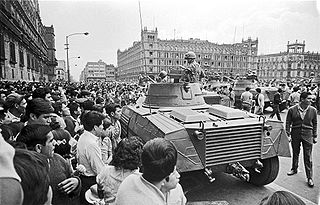
The Mexican Movement of 1968, also known as the Mexican Student Movement was a social movement composed of a broad coalition of students from Mexico's leading universities that garnered widespread public support for political change in Mexico. A major factor in its emergence publicly was the Mexican government's lavish spending to build Olympic facilities for the 1968 Olympics in Mexico City. The movement demanded greater political freedoms and an end to the authoritarianism of the PRI regime, which had been in power since 1929.

The Benito Juárez Autonomous University of Oaxaca is a public university located in the city of Oaxaca de Juárez in state of Oaxaca, Mexico.
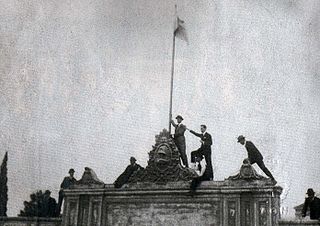
The Argentine university reform of 1918 was a general modernization of the universities, especially tending towards democratization, brought about by student activism during the presidency of Hipólito Yrigoyen. The events started in Córdoba and spread to the rest of Argentina, and then through much of Latin America. The reform set up the freedom for universities to define their own curriculum and manage their own budget without interference from the central government. This has had a profound effect on academic life at the universities through the nationalization process that boasts academic freedom and independence throughout the university life.
The 2010–2011 University of Puerto Rico strikes (UPR) refer to the student strikes which took place between May 2010 and June 2010 in ten of the university system's eleven constituent institutions, as well as the protests that occurred from October 2010 to February 2011.

El Halconazo was a massacre of student demonstrators by members of the Halcones, a state-sponsored paramilitary group, on 10 June 1971 in Mexico City. Occurring during the Mexican Dirty War, the massacre resulted in nearly 120 demonstrators being killed, among them a 14-year-old boy.
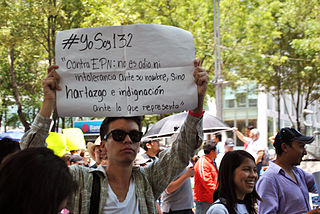
Yo Soy 132, commonly stylized as #YoSoy132, was a protest movement composed of Mexican university students from both private and public universities, residents of Mexico, claiming supporters from about 50 cities around the world. It began as opposition to the Institutional Revolutionary Party (PRI) candidate Enrique Peña Nieto and the Mexican media's allegedly biased coverage of the 2012 general election. The name Yo Soy 132, Spanish for "I Am 132", originated in an expression of solidarity with the original 131 protest's initiators. The phrase drew inspiration from the Occupy movement and the Spanish 15-M movement. The protest movement was known worldwide as the "Mexican spring" after claims made by its first spokespersons, and called the "Mexican occupy movement" in the international press.
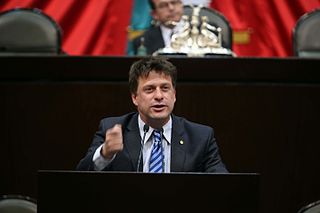
Fernando Belaunzarán Méndez is a politician affiliated with the PRD. As of 2013 he served as Congressman of the LXII Legislature of the Mexican Congress representing Mexico City.

The National Strike Council, the Consejo Nacional de Huelga (CNH) was created on August 2, 1968, composed of the National Autonomous University of Mexico (UNAM), the National Polytechnic Institute (IPN), El Colegio de Mexico, the School of Agriculture of Chapingo, the Universidad Iberoamericana, the Universidad La Salle and other universities in Mexico.
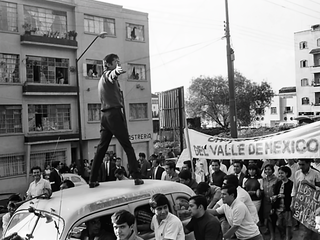
Los días y los años is a political novel and narrative account by Mexican author Luis González de Alba.
















